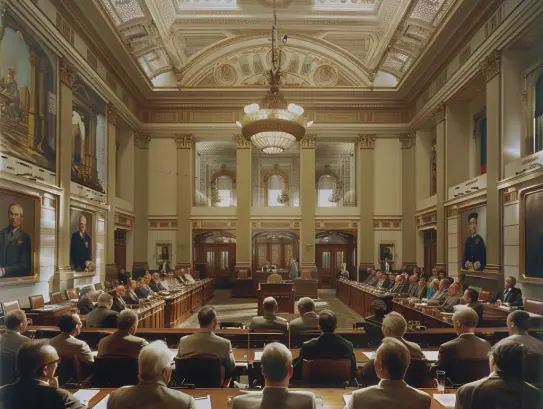
THE FUTURE OF DATA STORAGE
Overview
This project explores the future of data storage, focusing on the potential of DNA as the primary medium. Through strategic foresight and speculative design, it charts the anticipated rise and diverse applications of DNA in data storage.
Duration
8 Months
Methods
Speculative Design, Strategic Foresight
CONTEXT
Why DNA Could be Better
DNA is incredibly dense, an exabyte of data can theoretically fit in a space smaller than a sugar cube. It’s also exceptionally durable, with the potential to preserve data for thousands of years. These features, combined with rapid advances in sequencing technology, make DNA a promising alternative to traditional storage media.

Why This Future?
As artificial intelligence, IoT ecosystems, and big data fuel an insatiable demand for computing power, we’re trapped in a self-reinforcing cycle: the more data we generate, the more energy-hungry data centers we build, and the faster we exhaust Earth’s finite resources. Traditional storage, hard drives, magnetic tape, and cloud servers, is fragile, energy-intensive, and rapidly reaching its physical limits.
How Data is Stored in DNA
DNA data storage converts digital information into DNA sequences by mapping binary code (0s and 1s) to the four nucleotide bases: adenine (A), guanine (G), cytosine (C), and thymine (T). This allows data to be encoded, synthesized into DNA, and later read back using sequencing technology.

PROCESS

TREND ANALYSIS

Why is this happening?
As humanity increasingly relies on data-producing technology, data output grows exponentially. In turn, this necessitates more data centers, which generate unsustainable levels of carbon emissions.


EXPERT INTERVIEW
I facilitated a series of interviews with a DNA data storage researcher from CacheDNA. These interviews aimed to understand the direction of DNA data storage in the industry and how she believes it will most likely be used. This gave me a good sense of the probable future of the technology.
Key Insights
- While current read & write speeds are slow, advancements are expected to significantly accelerate in the near future.
- Although sequencing DNA is still costly, prices are steadily dropping, making it more accessible.
- Innovative methods and materials used in DNA storage are far more sustainable than conventional data storage processes.
- DNA-based data access is becoming increasingly intuitive, paving the way for wider adoption.
- DNA offers the remarkable potential for near-permanent data storage, enduring for centuries or longer.

SCENARIOS
I mapped out four scenarios using Dator's Four Futures framework: Growth, Collapse, Discipline, and Transformative. These scenarios were developed by analyzing current trends and projections while also exploring the potential future of DNA data storage.

WORLD BUILDING
For this project, I used world-building to develop future scenarios that explore emerging trends and guide strategic decisions. I applied the Protopia framework to build on the transformative scenario from Dator’s Four Futures, emphasizing continuous and realistic progress over utopian ideals. This approach helped create a more grounded and adaptive vision of the future, acknowledging challenges while highlighting opportunities for meaningful change.

The Year 2040
In this envisioned future, DNA data storage emerges as the primary medium, prized for its exceptional density, speed, and longevity. Traditional farmlands are transformed into high-tech data vaults, where genetically modified plants store vast amounts of information. This shift has spurred the rise of innovative tech hubs across the Midwest, reshaping education and job markets while fostering a dynamic interplay between technology and nature. Yet, this promising future faces its own set of challenges, ranging from the emergence of black markets for genetic data to pressing concerns over robust DNA security and the ethical implications of embedding data within living organisms.
IMPLICATION MAPPING
In this case study, implication mapping served as a strategic foresight tool to dissect and visualize the cascading impacts of emerging trends. By charting both direct and indirect effects across technology, society, the economy, the environment, the political, and values, we uncovered hidden opportunities and potential risks. This structured approach not only highlighted the ripple effects of key decisions but also informed proactive strategies and more nuanced decision-making throughout the project.

SACRIFICIAL ARTIFACTS
Sacrificial artifacts serve as intentionally imperfect prototypes that reveal critical trade-offs and hidden assumptions. By challenging conventional approaches and provoking dialogue around the balance between innovation and ethical responsibility, these artifacts illuminate the path toward more resilient, human-centric solutions.
FINAL CONCEPT
I selected Wired Magazine from the Future as my final prototype because it enabled me to create a cohesive narrative around an envisioned future, integrating diverse concepts into a unified story. This format allowed me to authentically mimic Wired’s editorial style, enhancing believability and impact. When I presented the prototype to a panel of futures practitioners, it received overwhelmingly positive feedback, highlighting its effectiveness in both storytelling and speculative exploration.

Page - of


This project was the culmination of my senior capstone in Industrial Design. Developed through the Experimental Realism mentorship program, I collaborated with several futures practitioners, with Ben Lowdon serving as my primary guide, to explore speculative design methodologies.





